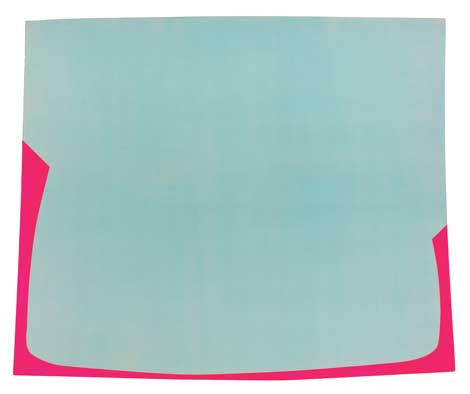I met Sheldon Figoten in San Francisco in the mid 1970s. We were just a couple of ambitious young artists from Los Angeles on sabbatical in California’s northern hemisphere at the time. After returning to SoCal, Figoten settled in Venice and over the years has become friends with many of its veteran abstract painters. Ed Moses, for one, is a longtime pal. Where Moses has had a storied career with countless solo exhibitions to show for it, Figoten has had fewer opportunities to show his equally thoughtful and skillful paintings. So he remains under the radar with a limited following, mainly among artists. If you are one of the enlightened, you know about his brightly colored Zen-like series of flow paintings that only recently ended. Although his current work is a departure, it is equally reductive in its approach to form and color.
Figoten has always been a superb colorist and a person who is unafraid to experiment with new paints and combinations. Paint itself, with its potential for exploitation and expression, is often what the work of an abstract painter is all about, and I know of no better example than his consummate poured pieces. A punctuation mark to this large body of work, coming as it did near the end, was the deliberate bending of the physical confines of the paintings. What was a subtle structural anomaly at first is now obvious and at the forefront. In another departure, Figoten hangs these uniquely shaped paintings at offbeat angles on the wall. It may feel unnatural, but what he gets from the skewed positioning is added attention to the shapes, which in turn reinforces the objectivity and optical suggestibility of the work. It isn’t an entirely new idea, but in his hands it’s a compelling one.
The final step in the process is an even-dusting of the interior colored surface of each painting with tiny glass beads. This adds luster and refracts the light in ways that can significantly alter perceptions as the viewer’s vantage point changes. In a way, the artist is revisiting the Light and Space movement by consolidating some of its precepts into an updated painting practice.
I’m afraid no amount of descriptive prose, not even the best photograph, can convey the experience of seeing Figoten’s new paintings in the flesh, and every situation in which they are viewed will slightly alter the experience. For all their unconventionality, they are not without historical precedent. During a recent studio visit, I asked the artist to elaborate. “My objective with these paintings is to do something new but at the same time acknowledge LA painters of the past. For me, John McLaughlin is unrivaled; his work and that of the other Hard Edge painters has definitely been a source of inspiration. I love those guys. But in the end it all comes down to this: the painting, the light and the viewer. It is what it is…and it is what it isn’t.”
All images photography by Brian Forrest




